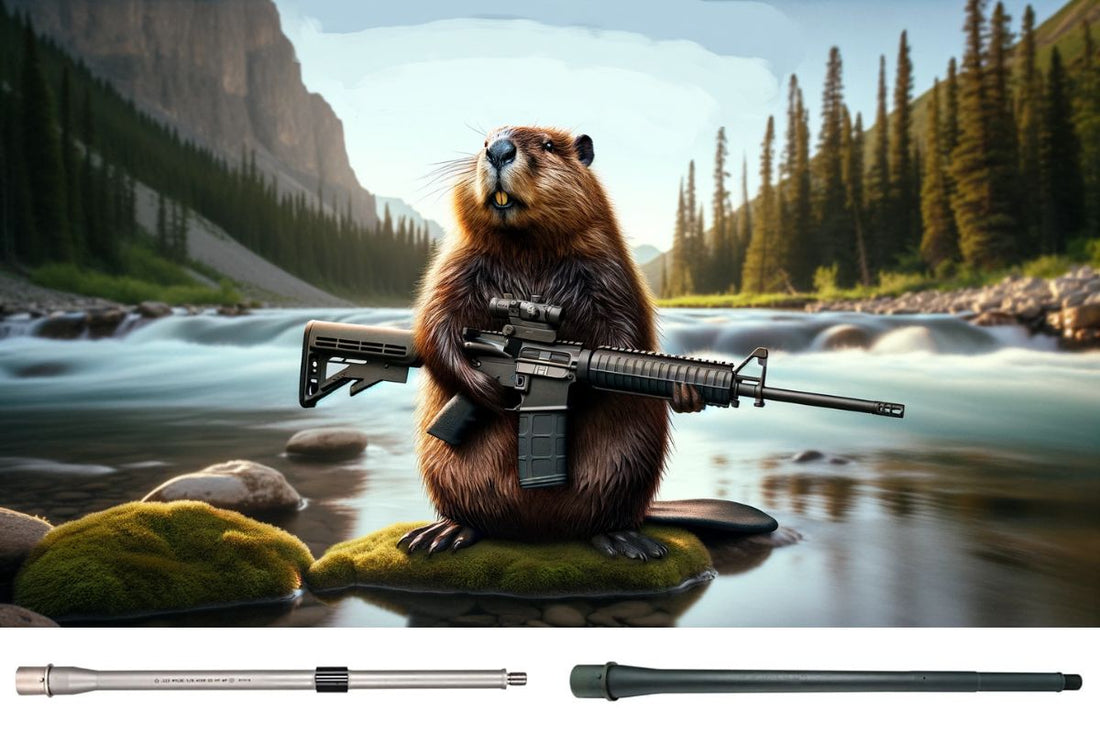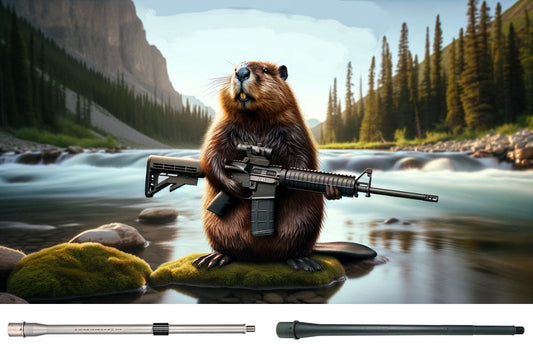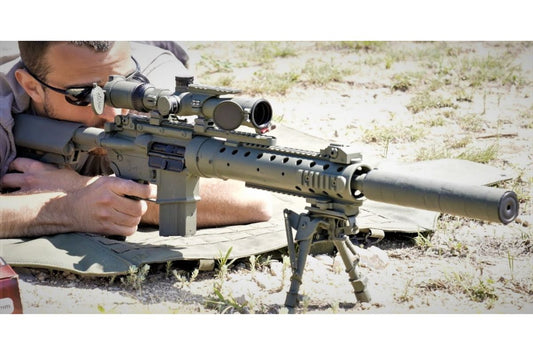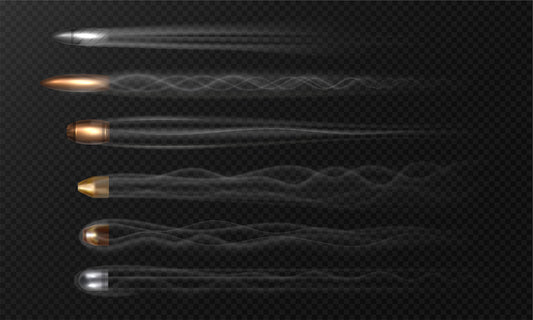
Barrel Length vs. AR-15 Accuracy: What Really Matters (and What Doesn’t)
TL;DR for Skimmers
Accuracy isn’t about length. Longer AR-15 barrels don’t inherently shoot smaller groups. They boost velocity, which helps hits at range via flatter drop/less wind drift. Shorter barrels are stiffer and often show excellent inherent precision, especially inside a few hundred yards. Barrel quality, twist, ammo, and gas tuning overshadow length. Pick length for mission—distance, handling, suppressor use—then buy a great barrel and feed it match ammo.
|
Factor |
How Barrel Length Influences It |
Practical Effect on “Accuracy” |
Notes |
|
Muzzle velocity |
Longer barrels give powder more time to accelerate the bullet |
Flatter trajectory, less wind drift at distance (easier hits) |
~20–30 fps/in. around/above 16"; much larger losses when cutting very short (6–14") |
|
Barrel stiffness (rigidity) |
Shorter barrels are stiffer; stiffness falls with the cube of length |
More consistent harmonics → strong inherent precision potential |
Rigidity ∝ diameter⁴; decreases with length³ |
|
Harmonics / whip |
Longer, thinner tubes “whip” more; short/fat tubes whip less |
Shorter barrels can be easier to tune for tight groups |
Classic barrel-maker notes on rigidity and accuracy |
|
Gas system / dwell time |
Longer barrels change port pressure and dwell, not group size |
Affects recoil impulse, reliability, and sight recovery |
Good barrel makers tune gas (port size/position) per length |
|
Twist rate & bullet match |
Not a length issue, but often paired with length options |
Proper twist stabilizes heavy bullets (e.g., 75–77gr) |
1:7–1:8 for 77gr .223/5.56 recommended by Sierra |
|
Handling & POI shift with heat |
Shorter = lighter & handier; can heat faster but whip less |
Faster transitions, less fatigue; watch mirage/heat |
Design/contour matters as much as raw length |
The Myth to Kill: “Longer Barrels Are More Accurate”
When shooters say a 20" is “more accurate,” they usually mean it’s easier to hit far targets because the bullet is faster, so it drops less and drifts less. That’s effective accuracy, not intrinsic precision. The actual group size potential depends more on barrel quality, contour, chamber, crown, ammo, and tune than raw length.
- Velocity reality: classic chop-tests in .223/5.56 show roughly 20–30 fps per inch around/above 16", and far steeper drops as you get into very short barrels (6–14")—often 80–100+ fps per inch in that zone. That’s why 10.5–12.5" guns give up a lot of reach. –rifleshooter.com
- Rigidity physics: stiffness drops with the cube of length and rises with the fourth power of diameter. Translation: shorter or thicker barrels move less, and less movement means more consistent barrel time for the bullet—good for precision. –accurateshooter.com
Barrel makers like Dan Lilja have hammered this home for decades: length and diameter together dictate stiffness, which underpins precision. –riflebarrels.com
What Changes as You Go From 10.5" → 12.5" → 14.5" → 16" → 18–20"?
1) Ballistics and “hit probability”
- More barrel = more speed. More speed means less time of flight, less gravitational drop, and less wind drift for a given wind call. That raises hit probability at distance even if the rifle’s raw group size hasn’t changed at all.
- Data point: cutting 5.56 barrels below 16" quickly taxes velocity—Rifleshooter’s series saw ~80–106 fps per inch in the 6–14" region across typical loads. Around 16" and longer, the slope flattens to ~20–30 fps/inch (rule of thumb). –rifleshooter.com
A useful mental model from the long-range world: small differences in muzzle velocity barely move hit probability compared to wind-call quality. Bryan Litz has publicly illustrated that even 100 fps shift in a .308 Win moves IPSC hit % at 1000 yards by only a couple of points. The takeaway carries into 5.56: velocity helps, but it’s not magic.
2) Mechanical precision potential
- Shorter barrels are stiffer and often easier to tune (less “whip”). That’s why so many benchrest recipes favor short-ish, fat tubes for tiny groups—not because they’re slow, but because they’re consistent oscillators.
- In AR-15 land, 10.5–12.5" can shoot shockingly well at 100–300 yards with the right barrel, gas, and ammo—but do the math on velocity if you need terminal performance or retained energy.
3) Gas system & shootability
- Longer barrels and tailored gas systems (port size/location) shape dwell time and recoil impulse. Companies like Proof Research explicitly design gas to the barrel length/cartridge to smooth cycling—not to shrink groups per se, but to make the rifle easier to shoot well. –ProofResearch.com
What Length Should You Choose? (Use-Case Driven)
Home defense / CQB / suppressed SBR (10.5–12.5")
Pros: Extremely handy, fast transitions, stiff tubes, great for suppressors; excellent 100–300 yd precision with quality ammo.
Cons: Big velocity penalty; some loads won’t fragment/expand reliably at distance; more sensitive to gas tuning (especially suppressed).
General-purpose carbine (14.5–16")
Pros: The sweet spot for most: manageable length/weight, solid velocity, broad ammo compatibility, and reliable mid-length gas options.
Cons: Slightly less handy than SBR; not as much velocity as 18–20" when you really stretch distance.
SPR / DMR / competition (18–20")
Pros: Maximum velocity in 5.56 within practical rifle lengths; flatter, less wind drift; pairs well with 75–77gr OTM for 600+ yd games.
Cons: Longer lever arm = less stiffness for a given contour; front-heavy if not intelligently profiled; more to carry.
Twist Rate & Ammo Matching: The Real Accuracy Gatekeeper
Length won’t fix unstable bullets. If you want consistent hits with 75–77gr heavy OTM favorites, choose 1:7 or 1:8 twist. Sierra’s own data calls out 1:7–1:8 as appropriate for 77–80gr bullets. If you’re shooting only 55–62gr, 1:9 works—but most modern AR builders wisely pick 1:7–1:8 for flexibility.
If you need a refresher on [rifling & twist rate], it’s the helical grooves that spin-stabilize bullets—longer, sleeker bullets need faster twist.
Concrete, Data-Driven Expectations by Length (5.56 / .223 Wylde)
- 10.5–12.5": Expect ~2400–2600 fps with 55–62gr loads, and significantly less with heavies. Trajectories steepen, wind drift increases. Great for inside 300 yds but choose ammo tailored for lower impact velocities if terminal performance matters. Precision can be excellent. (
- 14.5": Roughly +150–250 fps over a 10.5–12.5" with the same load. The common pinned/welded choice balances handiness with useful ballistics.
- 16": The “do-everything” default; mid-length gas makes for pleasant recoil behavior; velocity is a touch higher than 14.5", but not night-and-day in drop/drift.
- 18–20": Another +40–60 fps/inch over 16" (rule of thumb), better wind performance for 75–77gr match bullets. You’ll feel the extra length up front.
(Numbers vary by chamber, bore, lot, temperature, and suppressor use. But the shape of the curve is stable across tests.) –rifleshooter.com
What the Experts Say
- Dan Lilja (barrel maker) on rigidity & potential accuracy: “Both length and diameter are very important in determining barrel stiffness and potential accuracy.” –riflebarrels.com
- Applied Ballistics / Bryan Litz on the velocity obsession (context .308 but widely instructive): “Every 4" of barrel length is approximately 100 fps, which only changes hit % on an IPSC silhouette by 2–3% at 1000 yards.” (Implication: velocity helps, but fundamentals and wind calls matter more.)
Product Picks by Mission (All proven, thoughtfully engineered)
We’re intentionally recommending top-shelf, meticulously built components with smart profiles and gas solutions. Buy once, cry once.
Short, Stiff, Suppressor-Friendly (10.5–12.5")
- Criterion CORE 10.5–12.5" .223 Wylde (1:8) — CORE contours are designed for balance and harmonics; available across SBR lengths.
- Noveske 10.5" Stainless (Switchblock® options) — Stainless match pedigree, with gas control options that shine suppressed.
Why these? Stout shoulders near the chamber, smart tapers, and quality blanks keep harmonics tidy while staying compact.
General-Purpose “Do-All” (14.5–16")
- BCM Enhanced Light Weight 14.5" / 16" — Continuous taper and no abrupt shoulders optimize harmonics, with trustworthy gas porting.
- Ballistic Advantage 16" .223 Wylde BA Hanson — The Hanson contour is designed for harmonics and balance; pinned low-pro gas block included. Tremendous value.
- Faxon 14.5" Gunner (5.56) — Hybrid “Gunner” profile shifts weight rearward, reducing whip and fatigue without giving up durability; widely available.
Why these? They shoot well above their price class, balance handling and temperature management, and have civilized gas.
SPR / DMR, Stretch the Distance (18–20")
- White Oak Armament 18" SPR (.223 Wylde) — A classic for a reason; match pedigree and Ops/AE suppressor compatibility on select models.
- Proof Research Carbon-Fiber AR barrels (.223 Wylde) — Lighter out front with caliber-matched gas and excellent thermal characteristics; proven across match circuits.
- Daniel Defense 18" S2W / 16" LW CHF — Cold hammer forged durability with consistent accuracy; solid mid-length gas.
Why these? When you want more velocity while preserving practical precision, these profiles and chambers are known quantities.
Ammo Pairings & Twist Rate (Make Length Work for You)
- Short barrels (10.5–12.5"): Lean into modern bonded or monolithic loads engineered to expand at lower velocities; if shooting steel/PRS-style, use heavier OTMs (73–77gr) and confirm your dope. Twist 1:7–1:8 strongly preferred.
- 14.5–16" generalists: You can run the gamut from M193/M855 to match 69–77gr. If you care about real accuracy, buy 77gr SMK/OTM factory (e.g., Gorilla 77 SMK, Black Hills, IMI Razor Core) and watch your groups shrink.
- 18–20" SPRs: This is 77gr OTM territory. Use a 1:7–1:8 twist .223 Wylde chamber for seamless feeding and superb precision. Sierra’s own manuals back this twist for heavies.
Pros & Cons by Length
Short (10.5–12.5")
Pros:
- Extremely maneuverable, stiff, and often easier to tune.
- Suppressor-friendly; less overall OAL + weight.
- Superb practical precision inside 300 yards with heavy OTMs.
Cons:
- Large velocity drop; less margin for fragmentation/expansion and wind.
- Gas tuning more sensitive, especially suppressed.
- Legal/NFA considerations in many jurisdictions (verify locally).
Mid (14.5–16")
Pros:
- Balanced for nearly everything; ample gas options (mid-length).
- Velocity adequate for most duty/hunting/training needs.
- Huge ecosystem of proven, match-capable barrels.
Cons:
- Slightly longer/heavier than SBRs indoors or with long cans.
- Velocity still trails 18–20" for true distance play.
Long (18–20")
Pros:
- Best external ballistics in 5.56 across practical AR lengths.
- Pairs perfectly with 77gr match bullets for 600-yard games.
- Softer gas timing (often rifle-length), pleasant recoil impulse.
Cons:
- Less stiff for the same contour; must pick a smart profile.
- Front heavy if you don’t manage contour/handguard/can weight.
- Slightly slower to maneuver in barricades/vehicles.
Practical Build Recipes (Length-Specific, High-Quality)
Suppressed 12.5" GP Blaster
- Barrel: Criterion CORE 12.5" .223 Wylde (1:8), mid or carbine gas per your preference. (
- Use: 73–77gr OTM for targets; bonded 62–70gr for defense/hogs.
- Why: Stiff, balanced, and easy to shoot with a can.
Pinned 14.5" “Do-Everything” Carbine
- Barrel: BCM 14.5" Enhanced Light Weight (mid-length).
- Use: 69–77gr for accuracy, M193 for practice.
- Why: Smart taper minimizes whip; mid-length gas is civilized.
16" GP with Match Ambitions
- Barrel: Ballistic Advantage 16" .223 Wylde Hanson (pinned lo-pro gas block).
- Use: 77gr SMK/OTM for PRS-style carbine stages.
- Why: Purpose-tuned contour for harmonics; excellent value.
18" SPR / DMR
- Barrel: White Oak Armament 18" SPR (.223 Wylde) or Proof Research CF 18–20" with caliber-matched gas.
- Use: 75–77gr OTM; chrono and build a precise dope card.
- Why: Maximizes 5.56 external ballistics without drifting into unwieldy.
Lightweight 16" “All-Day” Trainer
- Barrel: Faxon 16" or 14.5" Gunner (pinned) for rear-biased balance.
- Use: 55–69gr for bulk practice; step to 73–77gr for matches.
- Why: Reduces fatigue and keeps harmonics predictable.
Testing Your Barrel’s Real Accuracy (Quick Protocol)
- Glass & position: Remove the shooter as a variable—quality optic, stable bags/bipod, and a clean trigger press.
- Ammo ladder: Try three loads minimum (e.g., 69 TMK, 75–77 OTM, and your bulk load).
- 5×5 method: Five 5-shot groups (not cherry-picked 3-shot clovers). Average group size and SD of muzzle velocity.
- Chrono & dope: Log temperature, pressure, and speed. Confirm drops at 300/500/600.
- Heat control: Keep a steady cadence; note group walking with heat (contour-dependent).
- Gas sanity check: If over-gassed (ejects at 1–2 o’clock, harsh recoil), fix gas first—shootability affects applied accuracy.
Contrarian Takes Worth Considering
- Ultra-short w/ heavy bullets + can: A 12.5" with a suppressor and 77gr may produce practical hit rates on small targets at 500 yards that rival a 16" unsuppressed, simply because the shootability and spotting trace/impacts improve.
- Carbon-fiber AR barrels: Not universally “stiffer,” but weight-for-weight they can net you lighter front ends without sacrificing accuracy—great for positional work where balance matters more than raw mass. Proof’s CAMGAS also helps cycling.
Common Misconceptions (and the Reality)
-
“Longer barrels are always more accurate.”
No. They’re faster, not inherently more precise. Shorter can shoot smaller—all else equal—because they’re stiffer. –accurateshooter.com -
“An 18–20" is mandatory for 600 yards.”
No. A 16" with 77gr and good wind calls can do it. The 18–20" just makes it easier via better ballistics. –rifleshooter.com -
“Twist rate is a length choice.”
No. Twist is about bullet length/weight, not barrel length. Pick twist for stability, then pick length for use-case.
Actionable Buying Guidance
- Pick length for the job (CQB/suppressed, GP carbine, SPR/DMR).
- Prioritize quality (bore finish, chamber, crown, extension fit).
- Select twist for your heaviest bullet (1:7–1:8 for 75–77gr).
- Choose a smart profile (continuous tapers like BCM ELW, Hanson, CORE, Gunner) that manage harmonics without nose-heaviness.
- Tune the gas (especially if suppressed). Proof’s CAMGAS or a well-ported mid/rifle system smooths recoil, helping you shoot to the barrel’s potential.
- Feed it match ammo when accuracy matters (e.g., 77gr SMK).
Example, Side-by-Side Choices (Direct-to-Product)
- 14.5" Balanced Duty/Training:
- BCM 14.5" Enhanced Light Weight (mid-length) — intelligent taper, great gas.
- Faxon 14.5" Gunner (mid-length) — rear-weighted hybrid for low fatigue.
- 16" All-Rounder, Match-Curious:
- Ballistic Advantage 16" .223 Wylde BA Hanson (pinned gas block included).
- Daniel Defense 16" LW CHF — durable CHF with solid accuracy.
- 18–20" SPR / DMR:
- White Oak Armament 18" SPR .223 Wylde — match pedigree and SPR features.
- Proof Research AR-Type .223 Wylde (carbon or steel) — weight savings + tuned gas.
(If you prefer a complete upper instead of a bare barrel, White Oak’s 18" SPR uppers are still a benchmark.)
Bottom Line
- Barrel length doesn’t directly determine precision. Shorter is often stiffer and easier to tune, while longer boosts velocity and therefore effective accuracy at range.
- For most shooters, 14.5–16" is the sweet spot. If you’re a suppressor-heavy, CQB-centric user, 10.5–12.5" makes sense—just choose ammo wisely. If you shoot small targets past 500, an 18–20" with 77gr OTM is money.
- Above all, buy a good barrel, pick the right twist, and match your ammo. The rest is gas tuning, fundamentals, and wind.




